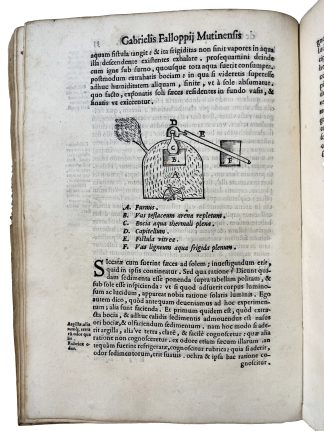FALLOPPIO, Gabriele.
MINERAL SPRING WATERS, GEOLOGY AND MEDICINE
De medicatis aquis atque de fossilibus.
Venice, Ludovico Avanzi, 1569.£4,750.00
FIRST EDITION? 4to. 2 works in 1, continuous signatures and pagination, ff. [32], 176. Roman letter, little Italic. Woodcut printer’s device to title, small ¼-page woodcut of distillation equipment, decorated initials and ornaments. Light age yellowing, occasional very minor marginal spotting and browning, marginal water stain to P1-2, 7-8, tear to margin of last leaf. A very good copy in contemporary limp vellum, lacking ties, early vellum reback (holed), early ms title to spine, a little chewing to fore- and lower edge of upper cover, c1600 ms ‘Andreas Falco[ne?]’ to upper cover, small vellum loss to lower. Modern bookplate and C17 pen trials to front pastedown, C17 Latin ms verse, old bookseller’s ink stamp and C18 pen trials to ffep, ms autograph ‘Jo[annes] Curt[ius?] mutuatus’ (i.e., borrowed) to title, occasional early ms notes in Latin, C17 ms ‘Il con(?) del (?) (?) è tondo’ to verso of rear fep.
A very good copy of probably the first edition of these important early works on therapeutic waters and fossils. Gabriele Falloppio (1523-62) was a major physician and anatomist, professor at Ferrara (where he taught Fabricius ab Aquapendente), Pisa and Padua. Several anatomical formations, of which he provided ground-breaking descriptions and studies, are still named after him, e.g., Fallopian tubes, ‘aquaeductus Fallopii’. ‘As with all of his publications except “Observationes anatomicae”, this work was published posthumously. It consists of two lectures given at Padua in 1556 and 1557 respectively, […] edited from lecture notes by Andreas Marcolini (fl. 1560), one of Fallopius’ friends’ (Heirs of Hippocrates).
‘De medicatis aquis’ is devoted to mineral spring waters and their therapeutic qualities. It introduces the names and nature of various spa waters, and proceeds to discuss why they emerge from the ground at very high temperatures (with a section on the rare instances in which they emerge cold), their metallic and mineral composition and how to investigate it (e.g., through sight and colour, smell, touch and taste), the ‘lutus thermalis’ (the therapeutic essence of spa waters), the application of mud, the medical characteristics of specific spa baths near Padua (e.g., Monte Ortone, San Pietro, Sant’Elena and Montegrotto, this last still in use and very popular, in an area named ‘Terme Euganee’) and in Emilia and Tuscany, and the benefits of spa waters for all kinds of conditions, head to foot. ‘De medicatis aquis’ is considered ‘the most influential work on solution analysis’ of the C16, for its discussion of the chemical composition of water (Debus, p.46).
‘De metallis seu fossilibus’ is concerned with geology and mineralogy. By ‘fossils’, like Agricola and Gesner, Falloppio meant ‘everything dug out of the ground or extracted from rocks that showed a distinct form […]. It included therefore, besides fossils in the modern sense […], also crystals, stones, minerals and artifacts’ (Etter, p.131). Falloppio focuses on stones and minerals to identify their medical properties, defining the types of soil, the nature and properties of stones, and the essence of metals (including less common substances like ‘chrysocolla’). Two most interesting works by one of the medical authorities of the Renaissance.
Another ed. appeared the same year, published by Avanzi with Giordano Ziletti – priority not established.
USTC 828698; EDIT16 CNCE 18531; Wellcome I, 2149; Durling 1431; Heirs of Hippocrates 336; Osler 2563. A. Debus, Chemistry, Alchemy, and the New Philosophy, 1550-1700 (1987); W. Etter, ‘Conrad Gessner and the Early History of Palaeontology’, in Conrad Gessner (1516-1565), ed. U. Leu et al. (2019), pp.129-44.In stock






